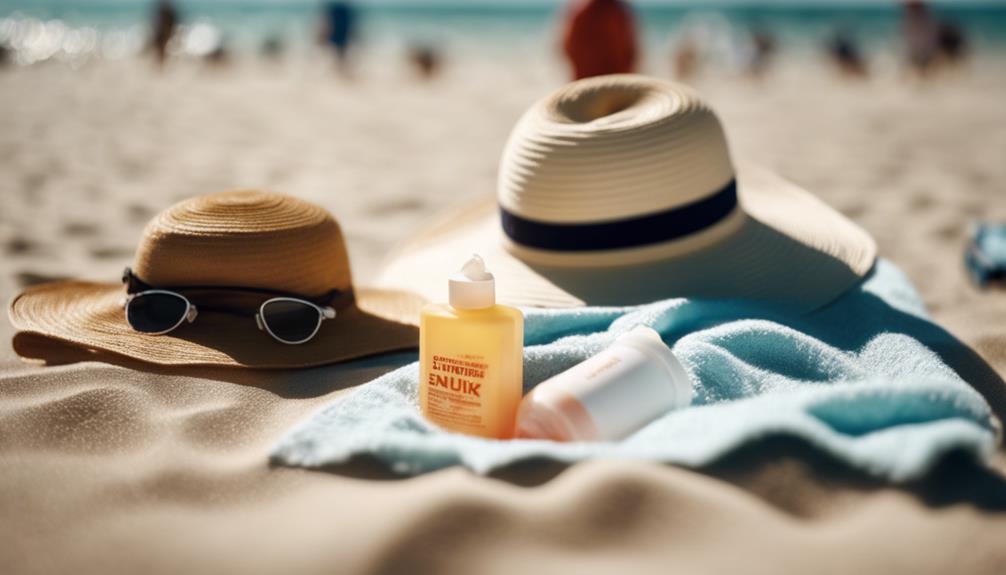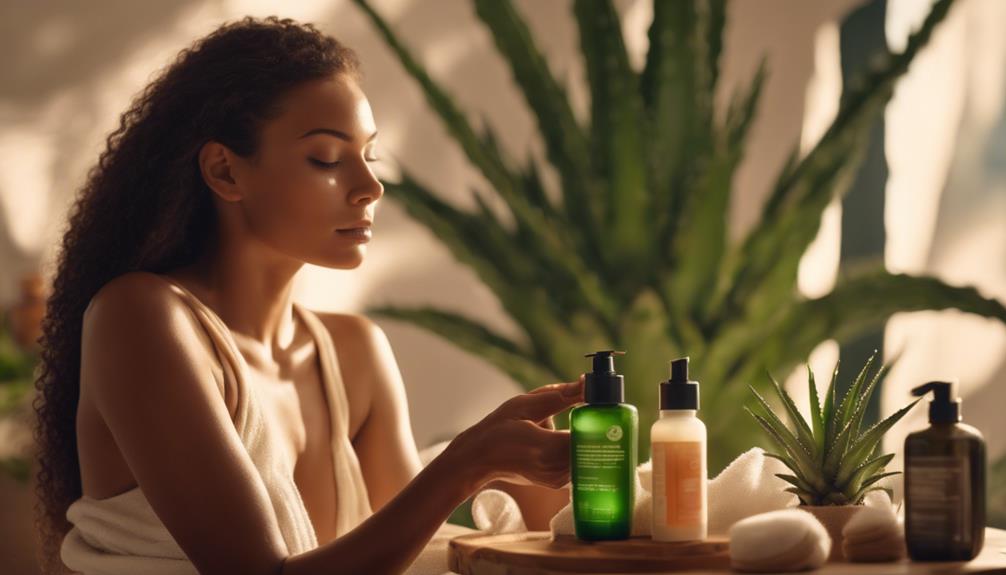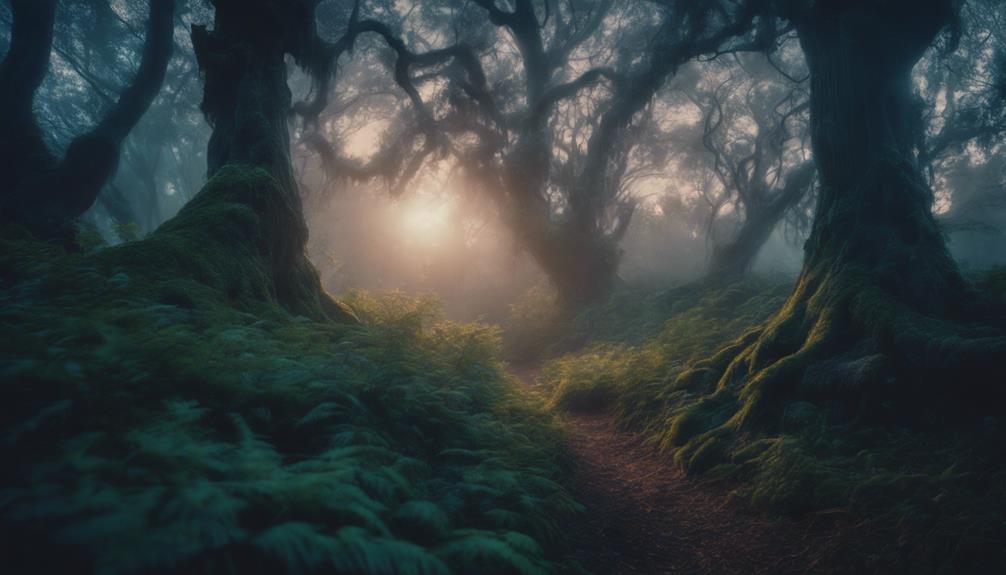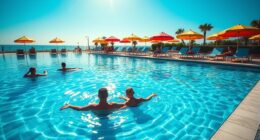You can achieve that coveted tan safely by understanding your skin type and adopting smart tanning practices. Always apply broad-spectrum sunscreen with at least SPF 30, even on cloudy days. Use self-tanning products with dihydroxyacetone (DHA) for a natural glow, and exfoliate before application for even results. Remember to keep sessions short, allowing your skin to adjust, and always monitor for any unusual reactions. Moisturize post-tan to prolong your glow and refresh your skin. Staying informed on safe practices maximizes your tanning experience while minimizing risks. There's so much more to discover about achieving that perfect tan safely.
Key Takeaways
- Understand your skin type using the Fitzpatrick Skin Type Scale to tailor safe tanning practices and monitor reactions to UV exposure.
- Apply broad-spectrum sunscreen with SPF 30 or higher before sun exposure and reapply every two hours for optimal protection.
- Use self-tanning products containing dihydroxyacetone (DHA) for a natural-looking tan while avoiding harmful UV rays.
- Follow a tanning schedule that includes short sessions, gradually increasing duration, and allowing skin recovery time between sessions.
Understanding Skin Types
Understanding your skin type is essential for safe tanning, as it determines how your skin reacts to UV exposure and what precautions you need to take.
The Fitzpatrick Skin Type Scale classifies skin into six categories, from Type I (very fair) to Type VI (deep skin tones). If you have fair skin (Types I-III), your lower melanin levels mean you're more prone to burning. You'll need to exercise greater caution during tanning sessions to avoid skin damage.
On the other hand, if you have darker skin (Types IV-VI), your higher melanin levels provide some natural protection against UV rays. However, don't let that give you a false sense of security. Even with darker skin, you can still suffer from skin damage without visible burns.
Understanding your skin type helps you determine safe tanning practices, like the appropriate duration for sun or tanning bed exposure. Always monitor your skin reactions to UV exposure, regardless of your melanin levels.
Safe Face Tanning Methods

To achieve a natural-looking face tan, choose self-tanning products designed specifically for your facial skin, ensuring they won't clog your pores. Look for options containing dihydroxyacetone (DHA), a key ingredient that reacts with your skin's outer layers to create a sun-kissed glow without harmful UV exposure.
Before applying any face tanning product, prioritize exfoliation. Regularly exfoliating removes dead skin cells, allowing for an even application that minimizes streaks and enhances your tan's appearance. Additionally, select products free from harsh chemicals to reduce the risk of skin irritation, especially if you have sensitive skin.
Once your tan is applied, always use a broad-spectrum sunscreen with at least SPF 30 to protect your skin from UV damage. This step is essential in maintaining your glow without exposing yourself to the risks associated with sunbathing.
Hydration is also important for keeping your skin healthy and radiant. Drink plenty of water and consider using hydrating serums or moisturizers to prolong your tan. By following these safe face tanning methods, you can confidently enjoy a beautiful, sun-kissed complexion.
Self-Tanning Product Options

Choosing the right self-tanning product can make all the difference in achieving a natural-looking tan that complements your skin tone. Self-tanning products, such as lotions, sprays, and mousses, use dihydroxyacetone (DHA) to give you that sun-kissed glow without the harmful effects of UV exposure. To avoid streaking and guarantee an even application, select a product that matches your specific skin tone.
If you have sensitive facial skin, opt for formulations designed for the face to prevent clogged pores and breakouts. Before applying your self-tanner, exfoliate your skin to remove dead cells, and be sure to moisturize dry areas like elbows and knees. This helps prevent uneven absorption, resulting in a smoother finish.
For those who prefer a more controlled approach, consider gradual tanning options. These products allow you to build your desired color over time, minimizing the risk of over-tanning or unwanted discoloration.
With the right self-tanning products and techniques, you can achieve a beautiful, bronzed look safely and effectively.
Effective Tan Removal Techniques

Even with the best self-tanning products, there may come a time when you want to remove an unwanted tan, and knowing effective techniques can help restore your skin's natural tone.
Start with exfoliating scrubs, which contain ingredients like sugar or salt to slough off dead skin cells. This process enhances your skin's natural renewal and can be quite effective for tan removal.
You might also consider skin lightening creams that feature active ingredients such as kojic acid or hydroquinone. These can gradually reduce tan pigmentation over time.
For a quick fix, try tan removal sprays and gels that incorporate exfoliating agents to dissolve unwanted color from your skin's surface.
If you prefer a DIY approach, natural ingredients like lemon juice can be gentle yet effective for lightening tans due to their acidity. Remember, consistent use of these products is key to restoring your original skin tone.
For stubborn tans, professional treatments like chemical peels offer faster results, but always consult a dermatologist for personalized advice.
With these techniques, you can effectively manage any unwanted tanning and keep your skin looking its best.
Preventative Anti-Tanning Strategies

Regularly applying broad-spectrum sunscreen with an SPF of 30 or higher helps protect your skin from harmful UV rays and considerably reduces the risk of tanning. To maximize your skin protection and minimize sun damage, consider these preventative anti-tanning strategies:
- Wear protective clothing: Opt for long sleeves, wide-brimmed hats, and UV-blocking sunglasses to shield your skin from direct sunlight.
- Seek shade: Stay out of the sun during peak hours, typically between 10 a.m. and 4 p.m., when UV radiation is the strongest.
- Reapply sunscreen: Make sure to reapply your sunscreen every two hours and after swimming to maintain effective protection.
- Understand your skin type: Use the Fitzpatrick Skin Type Scale to tailor your sun protection strategy and know your risk of sunburn and tanning.
Essential Skincare Tips

To achieve and maintain a healthy glow, it's essential to follow important skincare tips that support your skin's health and enhance your tanning experience.
Start by incorporating regular exfoliation into your routine 1-2 times a week. This practice removes dead skin cells, ensuring an even application of tanning products and prolonging the life of your tan.
Don't forget to hydrate! Using moisturizers with ingredients like hyaluronic acid and glycerin helps retain moisture, which enhances your skin's texture and glow.
Additionally, antioxidants, such as vitamins C and E, should be part of your skincare arsenal. They combat oxidative stress from UV exposure, promoting overall skin health.
Always apply a broad-spectrum sunscreen with at least SPF 30, even when using tanning products. This significant step provides UV protection, preventing skin damage and premature aging.
After you've tanned, focus on post-tan care by using soothing after-sun products. These will calm your skin and maintain hydration, helping to prevent peeling and uneven fading of your tan.
Monitoring Skin Health

Monitoring your skin health is just as important as following skincare tips, especially after tanning, to catch any potential issues early. Regular self-examinations and professional check-ups can help you stay on top of your skin's condition, especially after exposure to UV rays.
Here are some key practices to incorporate into your routine:
- Perform monthly self-examinations for unusual moles, spots, or texture changes.
- Schedule annual full-body skin checks with a dermatologist, especially if you have a history of excessive tanning sessions.
- Use the ABCDE rule (Asymmetry, Border, Color, Diameter, Evolving) to identify suspicious moles that might indicate skin cancer.
- Keep a log of your tanning sessions, noting the duration and products used, to recognize any adverse reactions.
Managing Tanning Risks

Managing tanning risks is essential for protecting your skin from harmful UV damage and reducing the chances of skin cancer. To achieve safe tanning, always apply a broad-spectrum sunscreen with at least SPF 30, even on cloudy days. This helps shield your skin from both UVA and UVB rays, which can lead to serious health issues like melanoma, particularly if you use tanning beds, known to emit UV rays at dangerously high levels.
Besides sunscreen, wearing protective gear like wide-brimmed hats and UV-blocking sunglasses can further reduce your risk of skin damage while enjoying outdoor activities.
Regularly check your skin for any signs of overexposure, such as redness, itching, or peeling, and take action if you notice any concerning changes. Staying hydrated is also critical; drinking plenty of water can help maintain your skin's health and mitigate some effects of tanning.
Incorporate moisturizers and antioxidants into your skincare routine to protect and nourish your skin. By following these steps, you can enjoy a beautiful tan while minimizing the risks associated with UV exposure. Safe tanning is all about balance and care for your skin!
Creating a Tanning Schedule

When you're creating a tanning schedule, it's essential to start with short sessions and gradually increase the duration.
Aim for 2-3 sessions per week, giving your skin time to recover between each one.
Keeping an eye on how your skin reacts will help you make any necessary adjustments to your routine.
Session Duration Guidelines
To create an effective tanning schedule, start with short sessions of 3-5 minutes to see how your skin reacts. This approach is especially critical for fair skin types (Fitzpatrick Types I-III) to minimize burn risk.
Gradually increase your session duration by 1-2 minutes each week, but make certain you don't exceed 10-15 minutes per session to avoid overexposure and potential skin damage.
Here are some key guidelines to follow:
- Monitor your skin closely after each session for any signs of redness or discomfort.
- Space tanning sessions at least 48 hours apart to allow your skin to recover.
- Aim for a maximum frequency of 2-3 sessions per week.
- Always stick to the manufacturer's exposure guidelines, as different tanning beds may have varying intensities.
Frequency and Monitoring
After determining your session durations, it's important to establish a consistent tanning frequency and monitor your skin's response to guarantee safe and effective tanning.
For various skin types, starting with 2-3 tanning sessions per week is preferable, ensuring at least 48 hours between sessions for proper skin recovery. This frequency helps you maintain an even tan while minimizing the risk of overexposure.
Pay close attention to your skin's reaction after each session. Look for signs of overexposure, like redness or peeling, and adjust your schedule accordingly. If you notice any adverse reactions, take breaks to allow your skin to recover fully before resuming tanning.
Always adhere to manufacturer guidelines regarding maximum exposure times, as they can vary based on the tanning bed's strength. Gradually increasing session durations, based on how your skin responds, is key to achieving best results.
Nourishing Your Skin Post-Tan

Moisturizing your skin with rich, hydrating lotions right after tanning is essential to prevent dryness and flaking. This not only maintains your glow but also supports overall skin health. You'll want to keep your skin hydrated and comfortable to guarantee a beautiful, even tan.
Here are some tips for nourishing your skin post-tan:
- Apply after-sun products that contain tan-enhancing ingredients to promote even fading.
- Drink plenty of water to maintain hydration and enhance the longevity of your glow.
- Take cool showers to soothe your skin and reduce irritation from UV exposure.
- Refrigerate hydrating serums and apply them for a revitalizing, cooling effect that aids in skin recovery.
Frequently Asked Questions
What Is the Safest Form of Tanning?
The safest form of tanning is self-tanning products containing dihydroxyacetone (DHA). They react with your skin's outer layer, giving you a natural-looking tan without harmful UV exposure. Just remember to use sunscreen for added protection!
What Is the Safest Way to Get a Real Tan?
The safest way to get a real tan is by using self-tanning products with DHA. You can also limit sun exposure, apply sunscreen, and choose gradual tanning lotions for a controlled, natural-looking glow.
How Do You Get a Healthy Glowing Tan?
Did you know 90% of skin aging comes from sun exposure? To get a healthy, glowing tan, use self-tanners with DHA, exfoliate regularly, hydrate your skin, and always apply sunscreen for protection.
How Can I Get Healthy Glow Without Tanning?
You can achieve a healthy glow without tanning by using bronzing lotions, applying makeup like bronzers, eating beta carotene-rich foods, exfoliating regularly, and hydrating your skin with moisturizers that contain antioxidants and hyaluronic acid.
Is the $5 Sunscreen an Effective Option for Safe Tanning?
When it comes to safe tanning, using a $5 sunscreen for UV protection may not be the best option. While it may provide some level of protection, it is important to invest in a higher quality sunscreen with broad-spectrum protection and a higher SPF to effectively shield your skin from harmful UV rays.
Conclusion
In your quest for that sun-kissed glow, remember that safety comes first.
By understanding your skin type and choosing the right tanning methods, you can enjoy a beautiful tan without putting your health at risk. Isn't it worth taking a few extra steps to protect your skin?
With effective removal techniques, preventative strategies, and proper post-tan care, you can maintain your glow while keeping your skin healthy.
Embrace the shine, but do it wisely!









